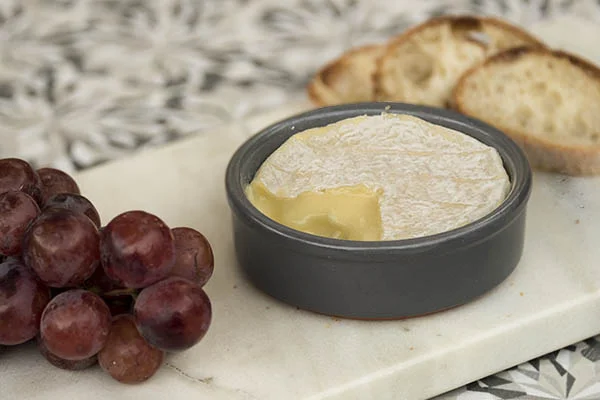“I don’t know if we’ve ever introduced a new cheese that has had this much instant acclaim,” said Vermont Creamery owner Allison Hooper about the recent debut of St. Albans. “We didn’t anticipate it.”
For the past year, Vermont Creamery has made this petite cow’s milk disk exclusively for Murray’s, the New York retailer that operates cheese kiosks in Kroger stores. Faced with the difficulty of importing raw-milk St. Marcellin, the beloved cheese from France’s Dauphiné region, Murray’s had turned to Vermont Creamery for a domestic pasteurized-milk replacement. After about six months of R&D, the St. Marcellin lookalike launched last fall, christened St. Mark’s.
With the exclusivity period ending, Vermont Creamery has introduced St. Albans, a cheese made from the same recipe but different milk. The milk for St. Mark’s comes from a Vermont cooperative. For St. Albans, the creamery uses Jersey milk from a single small farm in that co-op, the only farm willing to transition to certified non-GMO production.
“The co-op has been resistant for years,” Hooper told me. “Segregating milk is problematic, and the farmers were not really in agreement philosophically.” One concern was that cows wouldn’t produce as much milk on non-GMO feed, but Hooper says her supplier’s yield has not dropped.
Initial orders have been much stronger than Hooper and her team projected. “It’s Murphy’s Law,” she says. “When you have cheese in abundance, it moves slow. When you have limited availability, everybody wants it.” Translation: Be patient, people.
Like St. Marcellin, St. Albans is a lactic-set cheese, which means the milk is allowed to coagulate slowly, with minimal rennet. Geotrichum candidum added to the milk produces a soft, wrinkly rind after about 12 days. That’s when the little pucks (they weigh 2.8 ounces) are dry enough to tuck into their blue clay crocks. A perforated film wrap allows the cheese to continue to breathe and develop in transit.
The cheese is young and still fudgy when it leaves the creamery but it ripens quickly, says Hooper, because of the high ratio of rind to interior. Ideally, St. Albans should be all but collapsing when you cut into it; the crock provides support. Note the date stamp on the package, which is 60 days from the make day. If the cheese is less than a month old, you may want to give it a couple more weeks in your fridge to ensure that it’s properly gooey when you eat it. If you want it really oozy and spoonable, warm the whole cheese, still in its crock, in a 350°F oven until it softens.
I’ve tried St. Albans several times now. At its best, it has a seductive cheesecake smell with some faint mushroom notes. The texture is runny, almost as molten as fondue. The deep butter-yellow interior reflects the cows’ pasture diet, but presumably that color will pale when the herd goes off grass. The rind is thin and tender, with no hint of ammonia. For my palate, the salting is aggressive, but if you serve the cheese with potatoes or other "dippers," as the creamery suggests, you may want that high seasoning. Save your crocks for serving almonds or olives.
I'd love to try St. Mark's and St. Albans side by side, but I don't live anywhere near a Murray's kiosk. If you have that opportunity, it could be enlightening to see how much difference the milk makes.
In Northern California, look for St. Albans at Rainbow Grocery and Cowgirl Creamery in San Francisco; Pasta Shop in Oakland and Berkeley; most Whole Foods and Nugget Markets. It should be available soon at Bi-Rite and Cheese Plus in San Francisco; Cheese Board in Berkeley; and Oxbow Cheese Merchant in Napa. A creamy Rhone-style white wine, such as a Viognier, or a medium-intensity Pinot Noir would be a good match.


